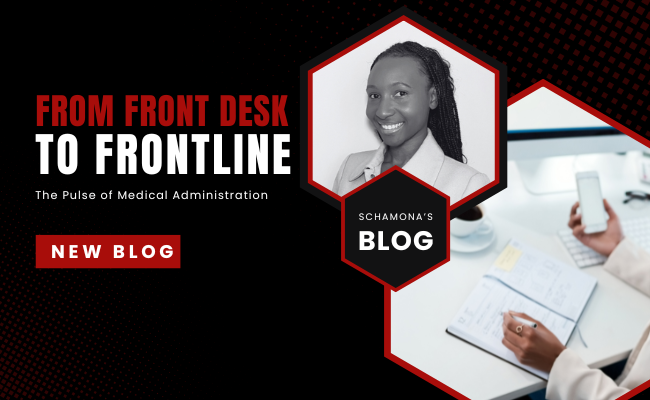Welcome to the heart of the matter—literally. Working as a medical secretary for a cardiology clinic has opened my eyes to the exasperating demands of medical administration. I used to think working the front desk in a clinic meant answering phones and scheduling patients. I was wrong. It’s about keeping the pulse of the practice steady, even when the beat gets a little chaotic. Whether it’s a flood of phone calls, faxes that never seem to stop, or the occasional “heart attack” of frustrated patients, there’s never a dull moment in this job. The most challenging part of this job is having to manage the overwhelming number of voicemails and emails that seem to multiply faster than heartbeats after a double espresso. And when you finally clear out that inbox, only to have it fill up again in seconds? Well, that’s just the way the heart beats.
Navigating Patient Care and Burnout
Speaking of heartbeats, let’s talk about patients. Emotions can run very high in any clinic. After all, this is a life or death business. But when patients are frustrated, scared, or just plain angry, it’s the front office staff who often feels the brunt of it. That coupled with the backlog of tasks can take a toll on our system. Now I might need the heart doctor. This emotional weight, coupled with the constant flow of administrative tasks, creates an overwhelming pressure. The reality is that these unrelenting demands can wear down even the most resilient of staff. The constant multi-tasking, patient interactions, and problem-solving—often in high-stress situations—can drain us physically and mentally.
Healthcare burnout is a real issue and continues to make headlines. Contrary to popular belief, it is not just physicians and nurses who feel the effects of increasing workload; administrative staff feels it too. We often find ourselves stretched between supporting clinicians, calming patients, and managing time-sensitive tasks, all while trying to maintain composure under pressure.The feeling of never quite catching up, of always having an inbox that refills faster than we can empty it, can create a sense of defeat. Add to that the emotional labour of interacting with patients who are understandably upset or anxious, and it’s no surprise that burnout looms large. A recent study found that the levels of burnout in the Canadian public health workforce are in the higher range among other public health workforces globally. 78.7% of respondents reported their increased levels of stress and burnout. Reducing administrative burdens is included in the data-proven top strategies we need to take to eliminate burnout.
Needless to say, administrative staff is often left out of the conversation, but it is as if we’re asked to be both the heart and backbone of the workplace. But who takes care of us when our systems start to waver? It’s time to recognize that while we are essential to the steady beat of the practice, even the strongest heart needs rest and support.
Addressing Healthcare Burnout: Solutions to the Problem
Every problem has a solution. While the demands of administrative tasks can be overwhelming, there are ways to combat burnout and create a healthier work environment. One solution is improving workflow efficiency through technology, such as automated systems that handle tasks like document triaging, scheduling and managing tedious tasks. Imagine not having to sit down for more than 30 minutes filling out a MVA or WSIB form, but instead actually providing care to at least two patients in that time period. By leveraging these tools, administrative staff and clinicians can reduce their workload and focus on more meaningful patient care.
Another important solution is promoting mental health in the workspace. Simple—yet rewarding. Regular check-ins, mental health days, and access to counselling services can make a world of difference in preventing burnout. Creating a culture of open communication, where staff feel supported in expressing their stress and challenges, is key to maintaining a resilient team. Additionally, investing in development opportunities can empower staff, ensuring they have access to the right resources needed to make their job less burdensome.
Ultimately, reducing burnout starts with acknowledging the critical role medical administrative professionals play and providing them with the tools, support, and balance they need to succeed.
In Conclusion
At the end of the day, no man is an island. Working in a clinic, hospital, or any other healthcare setting, is all about teamwork—whether it’s collaborating with clinicians or fellow administrative staff. Just like the heart relies on a network of veins and arteries to keep blood flowing, a clinic relies on its team to keep everything running smoothly. When a team comes together, regardless of the mountain of tasks pulling you in a million different directions, working in harmony, it’s a work of art. Being a part of the medical administrative staff requires patience, resilience, and the ability to keep cool under pressure. But it’s also incredibly rewarding. You’re not just managing appointments and paperwork—you’re playing a crucial role in patient care, ensuring that the clinic runs smoothly so that the doctors can focus on what they do best: caring for their patients. So, the next time you find yourself in the middle of a hectic day, remember—you’re the heartbeat of the clinic, and without you, nothing would run quite as smoothly.
Learn more about BHPN and our partnership with WaiveTheWait.

